| |
NIH Workshop on HIV in Older Adults Oct 20 2007
|
| |
| |
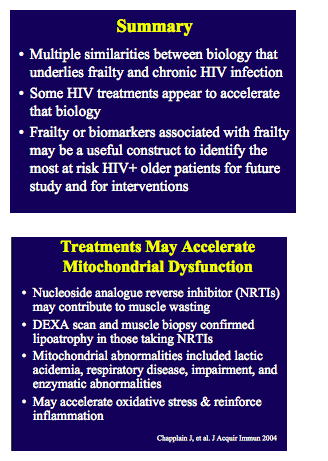

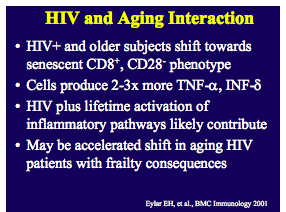

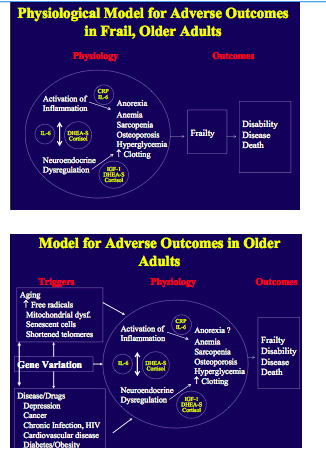

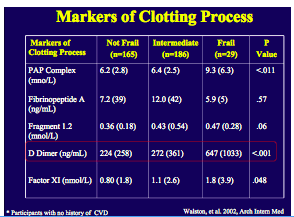
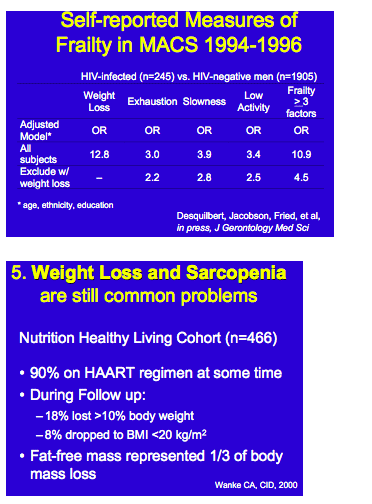
Sarcopenia can be defined as the age-related loss of muscle mass, strength and function (Waters, Baumgartner & Garry 2000; Vandervoort & Symons 2001). Although there is no specific level of lean body mass or muscle mass at which one can say sarcopenia is present (Roubenoff 2001), any loss of muscle mass is of importance because there is a strong relationship between muscle mass and strength (Roth, Ferrell & Hurley 2000). Sarcopenia appears to begin in the fourth decade of life and accelerates after the age of approximately 75 years (Waters, Baumgartner & Garry 2000). With aging and inactivity, the most atrophy is seen in the fast twitch (FT) fibers which are recruited during high-intensity, anaerobic movements. Although sarcopenia is mostly seen in physically inactive individuals, it is also evident in individuals who remain physically active throughout their lives. This finding suggests that physical inactivity is not the only contributing factor to sarcopenia. Current research is finding that the development of sarcopenia is a multifactorial process. Many factors, including physical inactivity, motor-unit remodeling, decreased hormone levels, and decreased protein synthesis, may all contribute to sarcopenia. Fortunately, sarcopenia is partly reversible with appropriate exercise interventions. This article will focus on the current perspectives of sarcopenia and conclude with the importance of resistance training in preventing it.
Workshop on HIV in Older Adults
Agenda
Discussion Topic I: Overarching Issues in HIV and Aging Research
The Natural History of Aging with HIV: Lessons Learned from 20+ years of the Multicenter AIDS Cohort Study (MACS), the Veterans Aging Cohort Study (VACS), and the Women's Interagency HIV Study (WIHS)
Amy C. Justice, MD, PhD
Lisa Jacobson, ScD
Immunologic Markers of Aging: Appearance in HIV-infected individuals, and what is known about their early, normal, and late appearance in HIV-infected subjects
Rita B. Effros, PhD
Janet E. McElhaney, MD
Discussion Topic II: Metabolic and Comorbidity Implications of HIV and Aging
Frailty and HIV: Similarities and differences versus aging, defining frailty for HIV-infected patients
Jeremy D. Walston, MD
Kris Ann Oursler, MD
HIV, Lipid Abnormalities, and Cardiovascular Disease
Phyllis Tien, MD
HIV and Renal Functional Decline and Disease
Christine K. Abrass, MD
Christina M. Wyatt, MD
HIV and Liver Disease
Marina B. Klein, MD
Mark Sulkowski, MD
Discussion Topic III: Immunology and Virology
Cellular Immunity in Aging and HIV Infection
Beth Jamieson, PhD
Edward Janoff, MD
Janet E. McElhaney, MD
Mucosal Immunity in HIV and Age-related Changes in Susceptibility to Infection
Rita B. Effros, PhD
Jiri Mestecky, MD, PhD
Loss of Resistance to Chronic Infections in Aging HIV-infected Patients (Tuberculosis, Hepatitis C, VZV, and HPV)
Kenneth E. Schmader, MD
Immunologic and Virologic Response to Anti-Retroviral Therapy
Michael M. Lederman, MD
Timothy W. Schacker, MD
Discussion Topic IV: Drug Treatment, Pharmacology, Polypharmacy, and Adherence
Appropriate Drug Dosing and Drug/Drug Interactions in Older Adults with HIV
Larry A. Mole, PharmD
John Williamson, PharmD
The Impact of Polypharmacy and Comorbidity on Adherence to Clinical Care Guidelines
Cynthia M. Boyd, MD
Wayne C. McCormick, MD
Workshop on HIV in Older Adults: Participants Roster
|
|
| |
| |
|
|
|